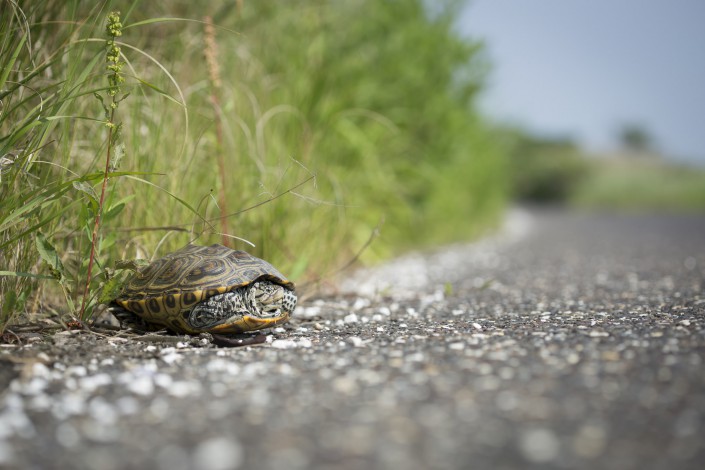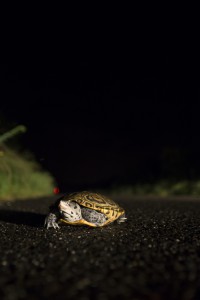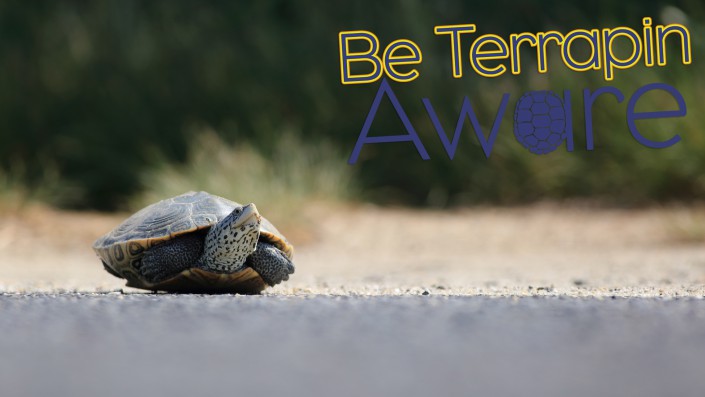NJDEP Closes Remainder of Terrapin Hunting Season
Urgent Protection for an Under-served Species in New Jersey
by Ben Wurst, Habitat Program Manager

Northern diamondback terrapins are considered a GAME SPECIES in New Jersey. It is (or was) legal to harvest any number of terrapins from New Jersey waters during their hunting season from November 1 to March 31. There were no permits, bag limits or reporting of catches, but they had to be caught by hand (using a rake or similar device). It must have been assumed that no one considered them a valuable species to catch since their value as a food source has diminished, but that is not the case and is why the New Jersey Department of Environmental Protection Commissioner Bob Martin signed an Administrative Order closing the remainder of the commercial harvest season this year. This is the second year that the season has been closed using an Administrative Order, and is a good reason for NJDEP to take terrapins off the game list and designate them as a non-game species.
“The diamondback terrapin has long been special to many people who live in or and visit our coastal communities,” said Commissioner Martin. “Many people have dedicated countless hours to protecting its habitats and raising awareness about this unique species. We need to ensure the terrapin remains part of our coastal ecosystem.”
Unfortunately, terrapins have been an under-served species for a long time in New Jersey. As a former major food source for Native Americans then European settlers, their population has only narrowly avoided being extirpated from our waters by their over exploitation in the late 19th century. Currently, their hunting season is full of unknowns and not one biologist in New Jersey can tell you the actual size of the population. Besides being hunted in winter, terrapins face a huge amount of threats (listed in order of severity): collecting for the pet and food trade, drowning in ghost crab pots, road mortality, habitat loss/shoreline hardening, collision with boat props and hulls, and predation. With all of these threats in their environment and not knowing the current status of their population, taking no action would be a huge mistake. Terrapins are not equipped to reproduce quickly and sustain their population when there are large (and unnatural) sources of mortality. They have very slow reproductive rates and very high mortality rates. Adult females do not reach sexual maturity until they are around 9-10 years old. In addition, only around 1-3% of terrapins are believed to live to adulthood. Recent studies have shown that adult females are becoming smaller and less numerous.

We’ve seen far too many terrapins face terrible deaths from our way of life. This is why we are leading many grassroots conservation efforts to protect terrapins in New Jersey. Since 2009, Conserve Wildlife Foundation of New Jersey has worked tirelessly to help reduce the amount of diamondback terrapin road-kills, to more accurately map their range, and to educate the public about their threats in the environment in the Great Bay and Barnegat Bay watersheds as part of the Great Bay Terrapin Project. Over the past 5 years we have cut the mortality rate of adult females in half to only 4% of adults that attempt to cross Great Bay Blvd. in Little Egg Harbor Twp. In 2015, with help from numerous dedicated volunteers, we documented a total of 906 individuals. Read our full report from 2015!
In 2015, we received 1,291 observations (not include our own) from various partners including a few from the public. Terrapins are extremely under reported from the general public. Most of the sightings that we get are not dispersed enough for them to be used to accurately depict their presence in their historic habitat throughout New Jersey. When they’re active during summer months the public is urged to report sightings of terrapins.
Lastly, we are the project leader for the development of a regional, multi-state strategy for Northern diamondbacks aimed at achieving long-term sustainability for terrapins throughout the Northern and Mid Atlantic Region (35 partners/8 states). We are also working with various partners and have gotten a grant from NOAA to find and remove ghost crab pots on Barnegat Bay, which is a huge threat to terrapins and other aquatic marine life.
Some more good news. This past month, the Endangered and Nongame Species Committee voted to accept the Delphi designation of “Special Concern” for the species. We sincerely hope that legislation to remove terrapins from the game list will not be delayed any longer.
Learn More:
- Read the full Executive Order 2016-02 to close the terrapin hunting season
- Learn more about our work to protect terrapins
- Learn more about the life history of terrapins
- Previous Terrapin blog posts

Ben Wurst is the Habitat Program Manager for Conserve Wildlife Foundation of New Jersey.
Discover more from Conserve Wildlife Foundation of NJ
Subscribe to get the latest posts sent to your email.
Leave a Comment
Hi. Please email me. I live on water in monmouth county with marshland on property and would love to host an introduction of terrapins to the local ecosystem. Thank you
I have been living in Fortescue for 10 years. WE NEED TURTLE SIGNS on FORTESCUE Rd before it crosses the marsh into Fortescue. It is a prime area for turtles crossing the road. Many locals stop to help them cross but every year careless drivers kill many turtles on this road. I have tried in the past to have someone place a sign but was told it is too costly. There are also wild cats at our south beach that kill baby turtles just because they are born hunters. The new road just paved and fortified with cement lego blocks last year caused at least 25 turtles every day, that i personally helped and saved,to be trapped in the hot tarred road. The turtles come ashore to lay their eggs, were falling 12 to 18 inches down onto the road and then walked back and forth searching for a way to get to the marsh to lay their eggs. Some were digging in crushed concrete trying to make a hole. Some were upside down in the hot sun. One man who lives down that end told me he helped 44 turtles one night. I have told this to our township committee and mayor who said he heard that same story already. They have changed the landscape so severely and it has changed the path of nature. Someone needs to be appointed, whether it be volunteers from our community, or game wardens, but in the past people show up around the time of hatching and they gather baby turtles in buckets. I asked a man once what he was doing and he told me he takes them somewhere to let them grow and then brings them back. I should have known better, i guess. The wild cats also have been seen standing on muskrat houses, chasing and killing baby mudhens, killing seagulls, and they have completely wiped out our rabbit population. We have an ordinance to not feed cats and residents here do it every day. We have an ordinance to pick up after our dogs but the cats have turned our beaches into their litterbox.
If you do start a program to work with the turtle safety i woulk like to know. I kayak the bay and back creeks and get to places not many people go. I see plenty of turtles and plenty, usually the same size dead that drowned in crab pots.
i think i have said it all.
thank you for the work you do.
I live on a freshwater pond and have a lot of turtles…I don’t know what kind they are, but I think some are Terrapins.Someone is welcome to come and study them. Also Monmouth County, Fair Haven.
I do know there is a population of large snapping turtles too. And if anyone is interested in trapping these for study, it would be fine. They eat the baby ducks.
Good job! In this day and age NO one should be eating this creature unless our modern world comes to an end and we are starving. Save the Earth!
Comments are closed.